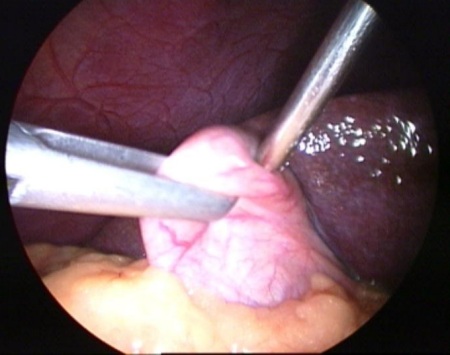
The gallbladder is a small sac located between the stomach and liver, which stores the bile secreted by the liver in order to deliver it to the small intestines when you eat. this bile helps in the digestion of fat. Typically a person has their gallbladder removed when it becomes diseased due to the formation of stones or cysts. Some 10%-15% of the adult population in the U.S. has gallstones, but only a small percentage of these patients develop them to such a size or extent that they cause a problem or even make the person aware of them. there may also be inflammation that leads to the blockage of the ducts in this area. this surgery is typically minor in nature with few complications. Most patients return home that day or the next, and can return to work and normal activities almost immediately.
When the gallbladder is removed this bile secreted by the liver can no longer be stored and delivered during meal times, and flows right into the intestines whenever it is produced. this means that there is still that necessary bile in the intestines but the amount is now being controlled the way it would be if the gallbladder were still present. Without a gallbladder you can still digest fat and rarely need to make adjustments to your diet that include a low-fat or nonfat diet.
As a matter of fact, the one common side effect to this surgery is recurring diarrhea, which occurs in about 10% of patients. this happens because the surge of bile that a gallbladder delivers when one eats helps to control how quickly the food is digested and sent through the system. Without the proper delivery of bile, the food moves too fast through the system and this causes diarrhea. of course, if any patient suffers from diarrhea after having a gallbladder removed, he or she needs to make sure to slow down while eating and to keep himself or herself properly hydrated.
Most gallbladder removal surgeries today are being done laparoscopically, meaning that rather than cut the patient open enough for the surgeon to see what he or she is doing, smaller incisions are made so that a tiny camera can be inserted into the patient which gives the surgeon visual access. The gallbladder is cut away and removed through these small incisions, as is the laparoscopic equipment and the incisions then closed. this means less risk of bleeding and other complications.
Having your gallbladder removed is typically a very routine procedure and nothing that any patient should be concerned with. It rarely interferes with one’s normal routine and can serve to protect your health in the long run.
If you are having problems after gall bladder surgery you should always talk with a nutritionist, or someone who is educated in this field and will be able to give you the best advice here. You should consider avoiding chocolate, ice cream, eggs, red meat, milk, coffee, nuts, beans, pork, onion, chicken, milk, oranges, grapefruit, corn, hydrogenated oils, saturated fats, fried foods and margarine.
Nutrition is the most important aspect when it comes to dealing with gall bladder symptoms, it is important that you get an adequate amount of exercise into your regular life, and even if this means that you just take a walk around the block a couple of times when you have some free time.
Always consult your doctor before using this information.
This Article is nutritional in nature and is not to be construed as medical advice.